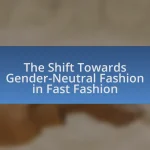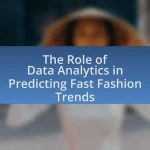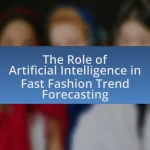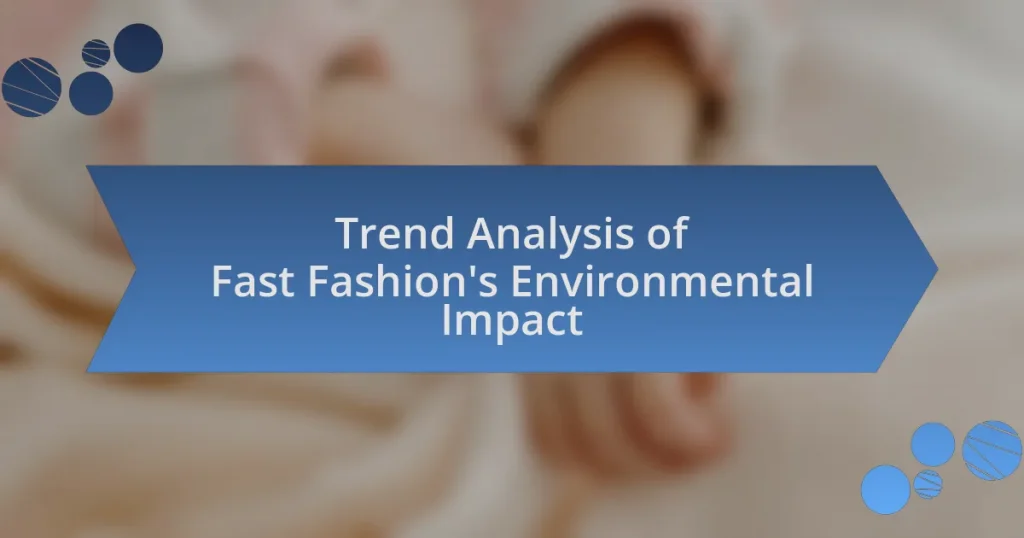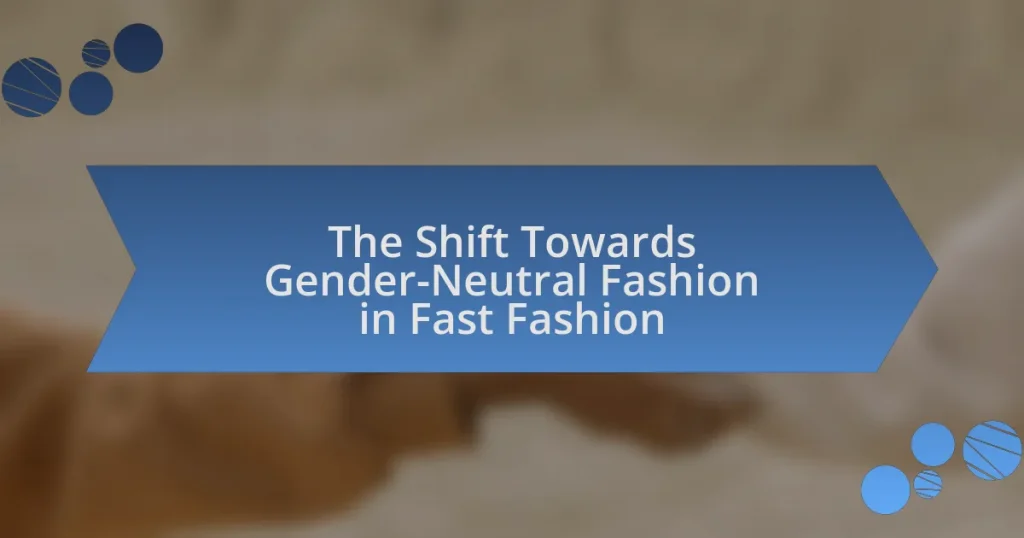Artificial Intelligence (AI) is transforming the fast fashion industry by enhancing trend forecasting through data analysis. AI algorithms analyze data from social media, online shopping behaviors, and fashion shows to predict consumer preferences and emerging trends, significantly reducing forecasting errors and optimizing inventory management. Key technologies involved include machine learning, natural language processing, and big data analytics, which collectively improve accuracy and efficiency in trend predictions. The article also addresses the challenges faced in trend forecasting, such as rapidly changing consumer preferences and data quality issues, while highlighting the ethical considerations of AI implementation in fast fashion.
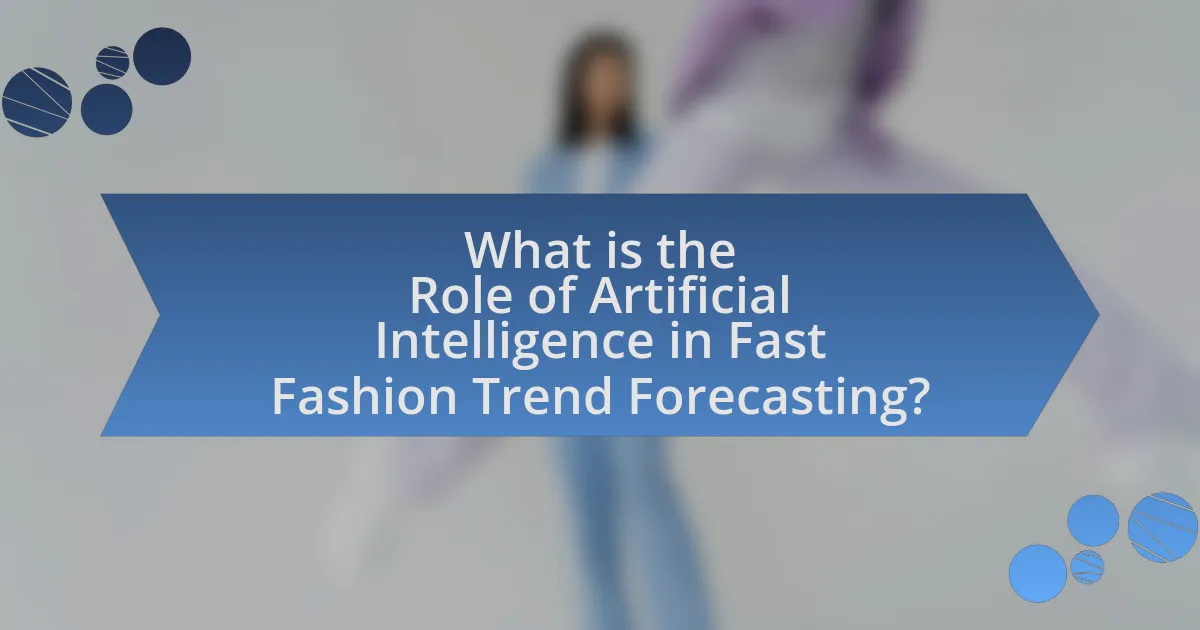
What is the Role of Artificial Intelligence in Fast Fashion Trend Forecasting?
Artificial Intelligence plays a crucial role in fast fashion trend forecasting by analyzing vast amounts of data to predict consumer preferences and emerging trends. AI algorithms process data from social media, online shopping behaviors, and fashion shows to identify patterns and insights that inform design and inventory decisions. For instance, a study by McKinsey & Company highlights that AI can reduce forecasting errors by up to 50%, enabling brands to respond more swiftly to market demands. This data-driven approach allows fast fashion retailers to optimize their supply chains, minimize waste, and enhance customer satisfaction by delivering products that align with current trends.
How does Artificial Intelligence influence trend forecasting in fast fashion?
Artificial Intelligence significantly enhances trend forecasting in fast fashion by analyzing vast amounts of data to predict consumer preferences and market trends. AI algorithms process data from social media, online shopping behaviors, and fashion shows, enabling brands to identify emerging styles and consumer demands in real-time. For instance, a study by McKinsey & Company found that companies using AI for trend forecasting can reduce forecasting errors by up to 50%, leading to more accurate inventory management and reduced waste. This data-driven approach allows fast fashion retailers to respond swiftly to changing trends, ensuring they remain competitive in a rapidly evolving market.
What technologies are involved in AI-driven trend forecasting?
AI-driven trend forecasting involves several key technologies, including machine learning, natural language processing, big data analytics, and computer vision. Machine learning algorithms analyze historical data to identify patterns and predict future trends. Natural language processing enables the analysis of social media and online content to gauge consumer sentiment and emerging trends. Big data analytics processes vast amounts of data from various sources, providing insights into market dynamics. Computer vision technology analyzes images and videos to detect fashion trends and styles. These technologies collectively enhance the accuracy and efficiency of trend forecasting in the fast fashion industry.
How do data analytics and machine learning contribute to trend predictions?
Data analytics and machine learning significantly enhance trend predictions by analyzing vast datasets to identify patterns and correlations. These technologies process historical sales data, social media trends, and consumer behavior to forecast future fashion trends with high accuracy. For instance, machine learning algorithms can analyze millions of data points in real-time, allowing brands to adapt quickly to emerging trends. A study by McKinsey & Company found that companies using advanced analytics in their decision-making processes can improve their forecasting accuracy by up to 30%. This integration of data analytics and machine learning enables fast fashion brands to make informed decisions, optimize inventory, and reduce waste, ultimately leading to a more responsive and efficient supply chain.
Why is trend forecasting important in the fast fashion industry?
Trend forecasting is crucial in the fast fashion industry because it enables brands to anticipate consumer preferences and market demands, ensuring timely production and inventory management. Accurate trend forecasting allows companies to reduce waste and respond quickly to changing fashion trends, which is essential in a market characterized by rapid shifts. For instance, a study by McKinsey & Company highlights that brands leveraging data analytics for trend forecasting can increase their sales by up to 20% by aligning their offerings with consumer desires. This strategic approach not only enhances profitability but also fosters customer loyalty by providing relevant products at the right time.
What impact does accurate trend forecasting have on inventory management?
Accurate trend forecasting significantly enhances inventory management by optimizing stock levels and reducing excess inventory. When businesses accurately predict consumer demand and fashion trends, they can align their inventory with market needs, leading to improved sales and minimized holding costs. For instance, a study by McKinsey & Company found that retailers using advanced analytics for trend forecasting can reduce inventory costs by up to 30% while increasing sales by 10-15%. This alignment not only improves cash flow but also enhances customer satisfaction by ensuring that popular items are readily available.
How does trend forecasting affect consumer satisfaction and brand loyalty?
Trend forecasting significantly enhances consumer satisfaction and brand loyalty by aligning product offerings with evolving consumer preferences. Accurate trend forecasting enables brands to anticipate market demands, ensuring that they deliver relevant products at the right time. For instance, a study by McKinsey & Company found that companies utilizing advanced analytics for trend forecasting can improve their inventory turnover by up to 30%, leading to better product availability and customer satisfaction. This responsiveness fosters a sense of trust and reliability among consumers, which in turn strengthens brand loyalty. When consumers feel that a brand understands and meets their needs, they are more likely to remain loyal and make repeat purchases.
What challenges does the fast fashion industry face in trend forecasting?
The fast fashion industry faces significant challenges in trend forecasting, primarily due to the rapid pace of consumer behavior changes and the unpredictability of fashion trends. This sector relies on quick turnaround times, which complicates the ability to accurately predict what styles will resonate with consumers. Additionally, the overwhelming volume of data from social media and online platforms can lead to information overload, making it difficult for brands to discern genuine trends from fleeting fads. Research indicates that 60% of fast fashion retailers struggle with aligning their production cycles with actual consumer demand, resulting in overproduction and waste. These factors collectively hinder effective trend forecasting in the fast fashion industry.
How do rapidly changing consumer preferences complicate forecasting?
Rapidly changing consumer preferences complicate forecasting by introducing unpredictability in demand patterns. This unpredictability arises from factors such as social media influence, cultural shifts, and technological advancements, which can lead to sudden changes in what consumers desire. For instance, a study by McKinsey & Company in 2021 highlighted that 66% of consumers changed their shopping behaviors during the pandemic, demonstrating how external events can rapidly alter preferences. Consequently, traditional forecasting models, which often rely on historical data, struggle to adapt to these swift changes, resulting in inaccurate predictions and potential overstock or stockouts in the fast fashion industry.
What limitations exist in current AI technologies for trend forecasting?
Current AI technologies for trend forecasting face several limitations, including data quality issues, lack of interpretability, and dependency on historical data. Data quality is crucial, as inaccurate or biased data can lead to flawed predictions; for instance, if the training data does not represent diverse consumer preferences, the AI may fail to capture emerging trends. Additionally, many AI models operate as “black boxes,” making it difficult for users to understand how decisions are made, which can hinder trust and adoption in industries like fast fashion. Furthermore, these technologies often rely heavily on historical data, which may not account for sudden market shifts or unprecedented events, limiting their effectiveness in rapidly changing environments.
How is Artificial Intelligence transforming the fast fashion landscape?
Artificial Intelligence is transforming the fast fashion landscape by enhancing trend forecasting, optimizing supply chain management, and personalizing customer experiences. AI algorithms analyze vast amounts of data from social media, sales patterns, and consumer behavior to predict fashion trends with greater accuracy. For instance, companies like Zara utilize AI to reduce lead times and respond swiftly to changing consumer demands, resulting in a 50% reduction in time from design to retail. Additionally, AI-driven recommendation systems personalize shopping experiences, increasing customer engagement and sales. This integration of AI not only streamlines operations but also aligns production with real-time market needs, fundamentally reshaping the fast fashion industry.
What are the ethical considerations of using AI in fast fashion?
The ethical considerations of using AI in fast fashion include labor exploitation, environmental impact, and consumer manipulation. Labor exploitation arises as AI can optimize production processes, potentially leading to increased demand for cheap labor in developing countries, where workers may face poor conditions and low wages. Environmental impact is significant, as AI-driven fast fashion can accelerate production cycles, contributing to waste and pollution; the fashion industry is responsible for 10% of global carbon emissions. Consumer manipulation occurs when AI algorithms analyze data to create targeted marketing strategies that encourage overconsumption, undermining sustainable practices. These considerations highlight the need for ethical frameworks to guide AI implementation in the fast fashion industry.
What specific applications of AI are used in fast fashion trend forecasting?
AI applications in fast fashion trend forecasting include predictive analytics, natural language processing (NLP), and computer vision. Predictive analytics utilizes historical sales data and consumer behavior to forecast future trends, enabling brands to optimize inventory and reduce waste. NLP analyzes social media and online reviews to gauge consumer sentiment and emerging trends, providing insights into what styles may become popular. Computer vision is employed to analyze images from fashion shows and social media platforms, identifying patterns and styles that are gaining traction. These applications collectively enhance the accuracy of trend forecasting, allowing fast fashion brands to respond swiftly to market demands.
How do social media analytics enhance trend forecasting accuracy?
Social media analytics enhance trend forecasting accuracy by providing real-time data on consumer preferences and behaviors. This data allows brands to identify emerging trends quickly, as social media platforms generate vast amounts of user-generated content that reflects current interests and sentiments. For instance, a study by McKinsey & Company found that companies leveraging social media insights can improve their forecasting accuracy by up to 30%, as they can analyze engagement metrics, hashtags, and user interactions to predict which styles or products will gain traction. This immediate feedback loop enables brands to adapt their strategies proactively, ensuring they remain relevant in a fast-paced market.
What role does predictive modeling play in trend analysis?
Predictive modeling plays a crucial role in trend analysis by utilizing historical data to forecast future trends and consumer behaviors. This statistical technique enables businesses to identify patterns and make informed decisions based on predicted outcomes. For instance, a study by McKinsey & Company highlights that companies using predictive analytics can improve their forecasting accuracy by up to 85%, allowing them to respond swiftly to market changes in the fast fashion industry. This capability not only enhances inventory management but also optimizes marketing strategies, ensuring that brands align their offerings with emerging trends effectively.
What best practices should brands follow when implementing AI for trend forecasting?
Brands should prioritize data quality and integration when implementing AI for trend forecasting. High-quality, diverse datasets enhance the accuracy of AI models, allowing brands to capture emerging trends effectively. For instance, a study by McKinsey & Company found that companies leveraging advanced analytics and AI in their forecasting processes can improve their forecast accuracy by up to 50%. Additionally, brands should ensure continuous model training and validation to adapt to changing consumer behaviors and market dynamics. This iterative approach allows for real-time adjustments, making the forecasting process more responsive and relevant. Furthermore, collaboration between data scientists and fashion experts is crucial, as it combines technical expertise with industry knowledge, leading to more insightful trend predictions.


